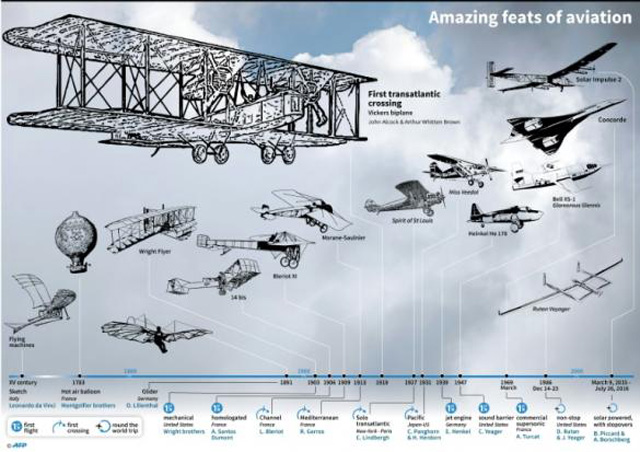
Paris, France | AFP | When two British pilots steered a biplane across the vast Atlantic 100 years ago, battling frozen sleet and thick fog for more than 16 hours, they were making aviation history.
With their harrowing 3,000-kilometre (1,860-mile) crossing, Captain John Alcock and navigator Lieutenant Arthur Whitten Brown completed the world’s first non-stop transatlantic flight.
Here is a look back at their groundbreaking journey between Newfoundland in Canada and Ireland on June 14-15, 1919.
– Daily Mail cash prize –
The North Atlantic had already been conquered by air when Alcock and Brown climbed into their modified World War I bomber on June 14 — but never in one go.
Just weeks earlier three US Navy Curtiss flying boats had set out from New York state to make the trip with stopovers in Newfoundland, the Azores, Portugal and England.
Only one completed the journey, covering 6,000 kilometres in three weeks.
Britain’s Daily Mail newspaper had laid down the challenge for a non-stop crossing by offering 10,000 pounds for a single flight from North America to the British Isles in under three days.
Just weeks ahead of the Alcock-Brown bid, two other teams had made an attempt: the first plane ditched into the ocean and was rescued; the second crashed on takeoff.
– Barely clears the trees –
Alcock, aged 26, and Brown, 32, took off in the early afternoon from St John’s, one of the easternmost points of North America.
Their Vickers Vimy biplane was weighed down by 4,000 litres (1,056 gallons) of fuel and only just able to clear the trees, lurching in gusts of wind.
“Several times I held my breath, from fear that our undercarriage would hit a roof or a tree-top,” Brown recalled in “Flying the Atlantic in Sixteen Hours” (1920).
Once airborne, the Royal Air Force aviators turned eastwards for Ireland, heading into the night.
– Flying blind –
Heavy fog meant they flew blind for much of the trip, unable to get their bearings.
The plane was tossed about by the wind, rising and plunging, at times just metres (feet) above the water, Alcock recounted afterwards.
“I believe we looped the loop and by accident we did a deep spiral. It was very alarming. We had no sense of the horizon,” Alcock told the Daily Mail.
Ice and hail jammed some of the instruments and threatened to freeze the motors. Brown had to chip off ice with a knife.
“We had a terrible trip. We never saw a boat, and we got no wireless messages at all,” Alcock said afterwards.
“We flew along the water and we had doubts as to our position, although we believed we were ‘there or thereabouts’. We looked out for land expecting to find it any time.”
– Irish bog landing –
When solid ground did suddenly appear in the morning of June 15, “it was great”, the pilot said.
He spotted what seemed a good field for a landing near Clifden in County Galway but it turned out to be a bog.
“The wheels sank axle deep in the field. The Vimy toppled over on her nose,” he said.
The plane was damaged but the two pioneers emerged unscathed. The trip had taken just over 16 hours.
– Heroes –
Alcock and Brown were welcomed as heroes in Dublin and London, handed the Daily Mail prize by Winston Churchill, then aviation minister, and later knighted by King George V.
Their record would however be overshadowed just eight years later when on May 20, 1927, American Charles Lindbergh made a transatlantic flight alone and between two major cities, from New York to Paris.
Alcock would die just six months after his feat, when his plane crashed near Rouen, France. Brown passed away in 1948.
 The Independent Uganda: You get the Truth we Pay the Price
The Independent Uganda: You get the Truth we Pay the Price



